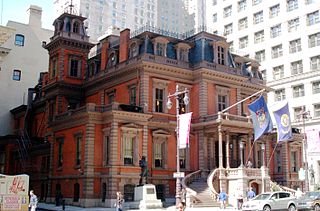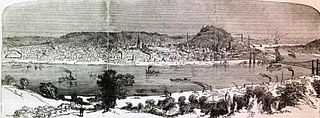
This section of the timeline of United States history concerns events from 1860 to 1899.

In the 1860s, the Copperheads, also known as Peace Democrats, were a faction of the Democratic Party in the Union who opposed the American Civil War and wanted an immediate peace settlement with the Confederates.

Mary Livermore was an American journalist, abolitionist, and advocate of women's rights. Her printed volumes included: Thirty Years Too Late, first published in 1847 as a prize temperance tale, and republished in 1878; Pen Pictures; or, Sketches from Domestic Life; What Shall We Do with Our Daughters? Superfluous Women, and Other Lectures; and My Story of the War. A Woman's Narrative of Four Years' Personal Experience as Nurse in the Union Army, and in Relief Work at Home, in Hospitals, Camps and at the Front during the War of the Rebellion. She wrote a sketch of the sculptor Anne Whitney for Women of the Day and delivered the historical address for the Centennial Celebration of the First Settlement of the Northwestern States in Marietta, Ohio on July 15, 1788.

During the American Civil War, the United States of America (USA) was referred to as the Union, also known colloquially as the North, after eleven Southern slave states seceded to form the Confederate States of America (CSA), which was called the Confederacy, also known as the South. The name the "Union" arose from the declared goal of the United States, led by President Abraham Lincoln, of preserving the United States as a constitutional union.

The American Civil War was the most widely covered conflict of the 19th century. The images would provide posterity with a comprehensive visual record of the war and its leading figures, and make a powerful impression on the populace. Something not generally known by the public is the fact that roughly 70% of the war's documentary photography was captured by the twin lenses of a stereo camera. The American Civil War was the first war in history whose intimate reality would be brought home to the public, not only in newspaper depictions, album cards and cartes-de-visite, but in a popular new 3D format called a "stereograph," "stereocard" or "stereoview." Millions of these cards were produced and purchased by a public eager to experience the nature of warfare in a whole new way.

The Union Leagues were quasi-secretive men's clubs established separately, starting in 1862, and continuing throughout the Civil War (1861–1865). The oldest Union League of America council member, an organization originally called "The League of Union Men", was formed in June 1862 in Pekin, Illinois. Four months later, on November 22, 1862, the Union League of Philadelphia, the first of the elite eastern Leagues and the second oldest ULA council member, was established.

Randolph Rogers was an American Neoclassical sculptor. An expatriate who lived most of his life in Italy, his works ranged from popular subjects to major commissions, including the Columbus Doors at the U.S. Capitol and American Civil War monuments.

Henry Whitney Bellows was an American clergyman, and the planner and president of the United States Sanitary Commission, the leading soldiers' aid society, during the American Civil War. Under his leadership, the USSC became the largest and most effective organization dedicated to supporting the health and efficiency of the Union army.

The United States Sanitary Commission (USSC) was a private relief agency created by federal legislation on June 18, 1861, to support sick and wounded soldiers of the United States Army during the American Civil War. It operated across the North, raised an estimated $25 million in Civil War era revenue and in-kind contributions to support the cause, and enlisted thousands of volunteers. The president was Henry Whitney Bellows, and Frederick Law Olmsted acted as executive secretary. It was modeled on the British Sanitary Commission, set up during the Crimean War (1853-1856), and from the British parliamentary report published after the Indian Rebellion of 1857.

During the American Civil War, the Ohio River port city of Cincinnati, Ohio, played a key role as a major source of supplies and troops for the Union Army. It also served as the headquarters for much of the war for the Department of the Ohio, which was charged with the defense of the region, as well as directing the army's offensives into Kentucky and Tennessee.

During the American Civil War, Philadelphia was an important source of troops, money, weapons, medical care, and supplies for the Union.

Camp Morton was a military training ground and a Union prisoner-of-war camp in Indianapolis, Indiana, during the American Civil War. It was named for Indiana governor Oliver Morton. Prior to the war, the site served as the fairgrounds for the Indiana State Fair. During the war, Camp Morton was initially used as a military training ground. The first Union troops arrived at the camp in April 1861. After the fall of Fort Donelson and the Battle of Shiloh, the site was converted into a prisoner-of-war camp. The first Confederate prisoners arrived at Camp Morton on February 22, 1862; its last prisoners were paroled on June 12, 1865. At the conclusion of the war, the property resumed its role as the fairgrounds for the Indiana State Fair. In 1891 the property was sold and developed into a residential neighborhood known as Morton Place, a part of the Herron-Morton Place Historic District.
During the American Civil War, Indianapolis, the state capital of Indiana, was a major base of supplies for the Union. Governor Oliver P. Morton, a major supporter of President Abraham Lincoln, quickly made Indianapolis a gathering place to organize and train troops for the Union army. The city became a major railroad hub for troop transport to Confederate lands, and therefore had military importance. Twenty-four military camps were established in the vicinity of Indianapolis. Camp Morton, the initial mustering ground to organize and train the state's Union volunteers in 1861, was designated as a major prisoner-of-war camp for captured Confederate soldiers in 1862. In addition to military camps, a state-owned arsenal was established in the city in 1861, and a federal arsenal in 1862. A Soldiers' Home and a Ladies' Home were established in Indianapolis to house and feed Union soldiers and their families as they passed through the city. Indianapolis residents also supported the Union cause by providing soldiers with food, clothing, equipment, and supplies, despite rising prices and wartime hardships, such as food and clothing shortages. Local doctors aided the sick, some area women provided nursing care, and Indianapolis City Hospital tended to wounded soldiers. Indianapolis sent an estimated 4,000 men into military service; an estimated 700 died during the war. Indianapolis's Crown Hill National Cemetery was established as one of two national military cemeteries established in Indiana in 1866.

Nevada's entry into statehood in the United States on October 31, 1864, in the midst of the American Civil War, was expedited by Union sympathizers in order to ensure the state's participation in the 1864 presidential election in support of President Abraham Lincoln. Thus Nevada became one of only two states admitted to the Union during the war and earned the nickname that appears on the Nevada state flag today: "Battle Born".
Sarah "Sallie" Middleton Robbins Broadhead was a teacher, diarist, and resident of Gettysburg, Pennsylvania during the Battle of Gettysburg. She was the author of The Diary of a Lady of Gettysburg, Pennsylvania from June 15 to July 15, 1863, which is a primary historical source for what happened during the battle and especially how it impacted the residents of the borough. It has been called the most comprehensive written document on the role of women in the Civil War. Ken Burns quoted entries from the diary in his 1990 documentary series, The Civil War.
The Metropolitan Fair was a public event organized in the Metropolitan City of New York by the United States Sanitary Commission to raise funds and supplies for the Union Army during the American Civil War, . The first Metropolitan Fair was announced by The New York Times on January 1, 1864, and to be held on March 28 of that year However, the event was postponed until April 4, and it resulted in the largest Sanitary Fair ever which raised over a million dollars for the Union cause.

Fort Marshall was a historical American coastal four-point bastion fort located in what is now the Highlandtown and Canton neighborhoods of Baltimore, Maryland. It was built at the outset the American Civil War in 1861, to protect the eastern approaches of Baltimore from Confederate attacks. The fort remained garrisoned for the duration of the war. After 1866, the fort's buildings were salvaged for other purposes and the area ultimately became the site of the Sacred Heart of Jesus Roman Catholic Church, surrounded by the developing residential neighborhoods of southeast Baltimore.
Elizabeth "Eliza" George, nicknamed "Mother George" by the Union army soldiers under her care, served the final two-and-a-half years of her life as a volunteer nurse in the South during the American Civil War. Initially discouraged from serving because of her age and the harsh conditions of wartime service, the fifty-four-year-old widow left her Fort Wayne, Indiana, home in February 1863 and died in May 1865 of typhoid fever, which she contracted while nursing soldiers and civilians at Wilmington, North Carolina, a month after the end of the war. George was buried with full military honors at Lindenwood Cemetery in Fort Wayne, Indiana; a monument erected near her gravesite pays tribute to her wartime service.

Elizabeth "Eliza" Harris served as a United States Sanitary Commission agent, army nurse, and newspaper correspondent during the American Civil War. She was active in the Eastern Theater of the American Civil War until September 1863, when she went to Tennessee for several months before returning to the east. After the war, she was active in national reform causes.

Northwestern Sanitary Fair was a fund-raising event of the United States Sanitary Commission (USSC), held in Chicago, Illinois. It opened on May 30 and closed on June 21, 1865. It was the second time such a Sanitary Fair was held in the city, the first time being in 1863. Although the civil war had come to a sudden close, there was still great need of funds to care for the disabled of the Union Army.
























